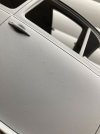Hi everyone,
I apologize if this has been posted before. I tried searching but probably looking in the wrong place.
I'm new to painting models and I'm currently working on a 1/10 scale automotive body. I'm at a stage where I've primed and wet sanded it (but still need a little more to do). However, because it's winter and I paint in a stairwell, I see some lint/dust no matter how careful I am. And, unfortunately, it's a larger scale. I'm not too worried about the primer getting dust because I can sand it but worried about the paint stage—since it's a gloss black (I'm using Tamiya TS rattle can paint). And also worried when I get to the gloss/clear coat.
What tips can you give me to prevent lint/dust on the model/primed/painted/coated surface? Do I just have to wet sand it after I paint it? And if I do, do I apply rubbing compound/polish only to the clear coat layer? And I read something about dryer sheets. Is that effective? And how is it used? Just wipe it on the model? Thanks in advance!
I apologize if this has been posted before. I tried searching but probably looking in the wrong place.
I'm new to painting models and I'm currently working on a 1/10 scale automotive body. I'm at a stage where I've primed and wet sanded it (but still need a little more to do). However, because it's winter and I paint in a stairwell, I see some lint/dust no matter how careful I am. And, unfortunately, it's a larger scale. I'm not too worried about the primer getting dust because I can sand it but worried about the paint stage—since it's a gloss black (I'm using Tamiya TS rattle can paint). And also worried when I get to the gloss/clear coat.
What tips can you give me to prevent lint/dust on the model/primed/painted/coated surface? Do I just have to wet sand it after I paint it? And if I do, do I apply rubbing compound/polish only to the clear coat layer? And I read something about dryer sheets. Is that effective? And how is it used? Just wipe it on the model? Thanks in advance!






